
An island or isle is a piece of land, distinct from a continent, completely surrounded by water. There are continental islands, which were formed by being split from a continent by plate tectonics, and oceanic islands, which have never been part of a continent. Oceanic islands can be formed from volcanic activity, grow into atolls from coral reefs, and form from sediment along shorelines, creating barrier islands. River islands can also form from sediment and debris in rivers. Artificial islands are those made by humans, including small rocky outcroppings built out of lagoons and large-scale land reclamation projects used for development.
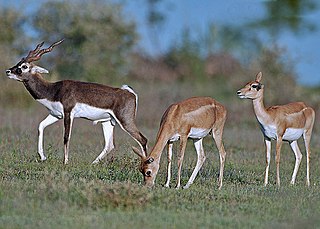
The term antelope refers to numerous extant or recently extinct species of the ruminant artiodactyl family Bovidae that are indigenous to most of Africa, India, the Middle East, Central Asia, and a small area of Eastern Europe. Antelopes do not form a monophyletic group, as some antelopes are more closely related to other bovid groups, like bovines, goats, and sheep, than to other antelopes.

Ex situ conservation is the process of protecting an endangered species, variety, or breed of plant or animal outside its natural habitat. For example, by removing part of the population from a threatened habitat and placing it in a new location, an artificial environment which is similar to the natural habitat of the respective animal and within the care of humans, such as a zoological park or wildlife sanctuary. The degree to which humans control or modify the natural dynamics of the managed population varies widely, and this may include alteration of living environments, reproductive patterns, access to resources, and protection from predation and mortality.
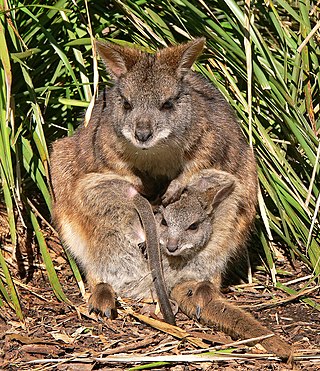
The parma wallaby is a small marsupial macropod mammal native to forests and densely-vegetated areas of northeastern New South Wales, Australia, close to the border with Queensland. There is also an introduced population found in and around Rodney District, just north of Auckland, New Zealand. About the size of a stout cat, it lives mainly under thick plant cover, and is only active at night when it emerges to feed on grasses and small plants. It is the smallest of the wallabies and carries its young in a pouch, as with other marsupials. Shy and elusive, it was believed extinct until its rediscovery in the 1960s.

Foster's rule, also known as the island rule or the island effect, is an ecogeographical rule in evolutionary biology stating that members of a species get smaller or bigger depending on the resources available in the environment. For example, it is known that pygmy mammoths evolved from normal mammoths on small islands. Similar evolutionary paths have been observed in elephants, hippopotamuses, boas, sloths, deer and humans. It is part of the more general phenomenon of island syndrome which describes the differences in morphology, ecology, physiology and behaviour of insular species compared to their continental counterparts.
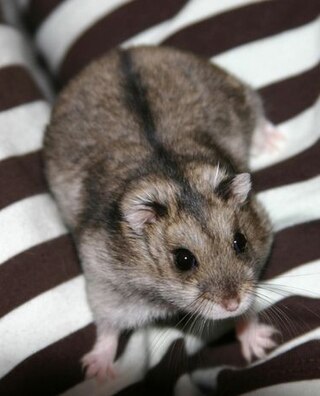
Campbell's dwarf hamster is a species of hamster in the genus Phodopus. It was given its common name by Oldfield Thomas in honor of Charles William Campbell, who collected the first specimen in Mongolia on July 1, 1902. It is distinguished from the closely related Djungarian hamster as it has smaller ears and no dark fur on its crown. Campbell's dwarf hamster typically has a narrow dorsal stripe compared to the Djungarian hamster and brown or gray fur on the stomach. This hamster may be raised in captivity and kept as a small pet.

African dwarf frog is the common name for members of Hymenochirus, a genus of aquatic frog native to parts of Equatorial Africa. They are common in the pet trade and are often mistaken for the African clawed frog, a similar-looking frog in the same family. Their common name is obtained from their place of origin and the claws on their hind legs.

Island gigantism, or insular gigantism, is a biological phenomenon in which the size of an animal species isolated on an island increases dramatically in comparison to its mainland relatives. Island gigantism is one aspect of the more general "island effect" or "Foster's rule", which posits that when mainland animals colonize islands, small species tend to evolve larger bodies, and large species tend to evolve smaller bodies. This is itself one aspect of the more general phenomenon of island syndrome which describes the differences in morphology, ecology, physiology and behaviour of insular species compared to their continental counterparts. Following the arrival of humans and associated introduced predators, many giant as well as other island endemics have become extinct. A similar size increase, as well as increased woodiness, has been observed in some insular plants such as the Mapou tree in Mauritius which is also known as the "Mauritian baobab" although it is member of the grape family (Vitaceae).
Extraterrestrial is a British-American two-part television documentary miniseries, aired in 2005 in the UK by Channel 4, by the National Geographic Channel in the US on Monday, May 30, 2005 and produced by Big Wave Productions Ltd. The program focuses on the hypothetical and scientifically feasible evolution of alien life on extrasolar planets, providing model examples of two different fictional worlds, one in each of the series's two episodes.
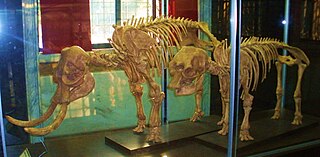
Insular dwarfism, a form of phyletic dwarfism, is the process and condition of large animals evolving or having a reduced body size when their population's range is limited to a small environment, primarily islands. This natural process is distinct from the intentional creation of dwarf breeds, called dwarfing. This process has occurred many times throughout evolutionary history, with examples including various species of dwarf elephants that evolved during the Pleistocene epoch, as well as more ancient examples, such as the dinosaurs Europasaurus and Magyarosaurus. This process, and other "island genetics" artifacts, can occur not only on islands, but also in other situations where an ecosystem is isolated from external resources and breeding. This can include caves, desert oases, isolated valleys and isolated mountains. Insular dwarfism is one aspect of the more general "island effect" or "Foster's rule", which posits that when mainland animals colonize islands, small species tend to evolve larger bodies, and large species tend to evolve smaller bodies. This is itself one aspect of island syndrome, which describes the differences in morphology, ecology, physiology and behaviour of insular species compared to their continental counterparts.
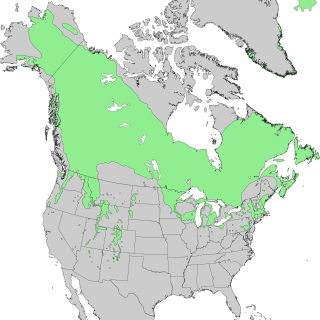
Species distribution, or speciesdispersion, is the manner in which a biological taxon is spatially arranged. The geographic limits of a particular taxon's distribution is its range, often represented as shaded areas on a map. Patterns of distribution change depending on the scale at which they are viewed, from the arrangement of individuals within a small family unit, to patterns within a population, or the distribution of the entire species as a whole (range). Species distribution is not to be confused with dispersal, which is the movement of individuals away from their region of origin or from a population center of high density.

The Palawan stink badger, pantot or tuldo in the Batak language, is a carnivoran of the western Philippines named for its resemblance to badgers, its powerful smell, and the largest island to which it is native, Palawan. Like all stink badgers, the Palawan stink badger was once thought to share a more recent common ancestor with badgers than with skunks. Recent genetic evidence, however, has led to their re-classification as one of the Mephitidae, the skunk family of mammals. It is the size of a large skunk or small badger, and uses its badger-like body to dig by night for invertebrates in open areas near patches of brush. While it lacks the whitish dorsal patches typical of its closest relatives, predators and hunters generally avoid the powerful noxious chemicals it can spray from the specialized anal glands characteristic of mephitids.

Hațeg Island was a large offshore island in the Tethys Sea which existed during the Late Cretaceous period, probably from the Cenomanian to the Maastrichtian ages. It was situated in an area corresponding to the region around modern-day Hațeg, Hunedoara County, Romania. Maastrichtian fossils of small-sized dinosaurs have been found in the island's rocks. It was formed mainly by tectonic uplift during the early Alpine orogeny, caused by the collision of the African plate and Eurasian plate towards the end of the Cretaceous. There is no real present-day analog, but overall, the island of Hainan is perhaps closest as regards climate, geology and topography, though still not a particularly good match. The vegetation, for example, was of course entirely distinct from today, as was the fauna. Places like Louisiana and Mississippi and other parts of the Deep South are an even closer climatic and ecological match with a subtropical climate, wet summer season, coverage by rivers, swamps, and deltas, however they are not islands.

The Cozumel raccoon is a critically endangered species of island raccoon endemic on Cozumel Island off the coast of the Yucatan Peninsula, Mexico. It is sometimes also called the pygmy raccoon, dwarf raccoon, Cozumel Island raccoon, and Cozumel raccoon bear.

Several species of Malagasy hippopotamus lived on the island of Madagascar but are now believed to be extinct. The animals were very similar to the extant hippopotamus and pygmy hippopotamus. The fossil record suggests that at least one species of hippopotamus lived until about 1,000 years ago and other evidence suggests that the species may have survived until much more recently. The taxonomy of these animals is not resolved and not widely studied.
Island ecology is the study of island organisms and their interactions with each other and the environment. Islands account for nearly 1/6 of earth’s total land area, yet the ecology of island ecosystems is vastly different from that of mainland communities. Their isolation and high availability of empty niches lead to increased speciation. As a result, island ecosystems comprise 30% of the world’s biodiversity hotspots, 50% of marine tropical diversity, and some of the most unusual and rare species. Many species still remain unknown.
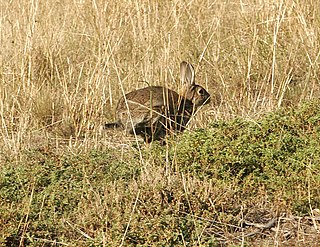
Vermin (colloquially varmint(s) or varmit(s)) are pests or nuisance animals that spread diseases and destroy crops, livestock, and property. Since the term is defined in relation to human activities, which species are included vary by region and enterprise.
Dwarf, dwarfs or dwarves may refer to:
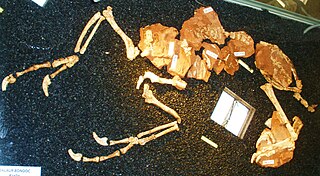
Balaur is a genus of theropod dinosaur from the late Cretaceous period, in what is now Romania. It is the type species of the monotypic genus Balaur, after the balaur, a dragon of Romanian folklore. The specific name bondoc means "stocky", so Balaur bondoc means "stocky dragon" in Romanian. This name refers to the greater musculature that Balaur had compared to its relatives. The genus, which was first described by scientists in August 2010, is known from two partial skeletons. Some researchers suggest that the taxon might represent a junior synonym of Elopteryx.

Island syndrome describes the differences in morphology, ecology, physiology and behaviour of insular species compared to their continental counterparts. These differences evolve due to the different ecological pressures affecting insular species, including a paucity of large predators and herbivores as well as a consistently mild climate.
















